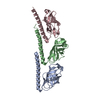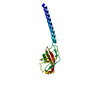+検索条件
-Structure paper
| タイトル | Two distinct archaeal type IV pili structures formed by proteins with identical sequence. |
|---|---|
| ジャーナル・号・ページ | Nat Commun, Vol. 15, Issue 1, Page 5049, Year 2024 |
| 掲載日 | 2024年6月14日 |
 著者 著者 | Junfeng Liu / Gunnar N Eastep / Virginija Cvirkaite-Krupovic / Shane T Rich-New / Mark A B Kreutzberger / Edward H Egelman / Mart Krupovic / Fengbin Wang /   |
| PubMed 要旨 | Type IV pili (T4P) represent one of the most common varieties of surface appendages in archaea. These filaments, assembled from small pilin proteins, can be many microns long and serve diverse ...Type IV pili (T4P) represent one of the most common varieties of surface appendages in archaea. These filaments, assembled from small pilin proteins, can be many microns long and serve diverse functions, including adhesion, biofilm formation, motility, and intercellular communication. Here, we determine atomic structures of two distinct adhesive T4P from Saccharolobus islandicus via cryo-electron microscopy (cryo-EM). Unexpectedly, both pili were assembled from the same pilin polypeptide but under different growth conditions. One filament, denoted mono-pilus, conforms to canonical archaeal T4P structures where all subunits are equivalent, whereas in the other filament, the tri-pilus, the same polypeptide exists in three different conformations. The three conformations in the tri-pilus are very different from the single conformation found in the mono-pilus, and involve different orientations of the outer immunoglobulin-like domains, mediated by a very flexible linker. Remarkably, the outer domains rotate nearly 180° between the mono- and tri-pilus conformations. Both forms of pili require the same ATPase and TadC-like membrane pore for assembly, indicating that the same secretion system can produce structurally very different filaments. Our results show that the structures of archaeal T4P appear to be less constrained and rigid than those of the homologous archaeal flagellar filaments that serve as helical propellers. |
 リンク リンク |  Nat Commun / Nat Commun /  PubMed:38877064 / PubMed:38877064 /  PubMed Central PubMed Central |
| 手法 | EM (らせん対称) |
| 解像度 | 3.47 - 3.89 Å |
| 構造データ | EMDB-41283, PDB-8tib: EMDB-41286, PDB-8tif: |
| 由来 |
|
 キーワード キーワード | PROTEIN FIBRIL / helical symmetry / type iv pili / archaeal pilus / filament / quasi-equivalence |
 ムービー
ムービー コントローラー
コントローラー 構造ビューア
構造ビューア 万見文献について
万見文献について








 sulfolobus islandicus rey15a (好気性・好酸性)
sulfolobus islandicus rey15a (好気性・好酸性)